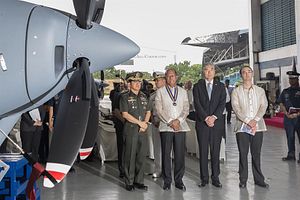On Tuesday, the United States officially handed over the first new drones for the Philippine military that were transferred through foreign military financing. Though the official handover merely formalized an arrangement that had already been in the works since last year, it nonetheless was significant as both a contribution to the Philippines’ still-limited military capabilities as well as an indicator of the continuing defense cooperation underway in the U.S.-Philippine alliance despite the challenges posed by Philippine President Rodrigo Duterte.
As I have been noting in these pages, despite the occasional hype that emerges around U.S. surveillance activities in the Philippines, Washington has had a longstanding presence there partly rooted in assisting with providing capabilities Manila does not have and badly needs (See: “What’s Behind the New US-Philippines Drone Hype Under Duterte?”).
That has continued on under Duterte in spite of the challenges he has posed to the alliance. In particular, with the outbreak of the five-month long siege on the southern city of Marawi last year, U.S. surveillance support to the Philippines was stepped up, leading to various forms of assistance including drones, such as the Aerovironment RQ-11 Raven hand-launched UAVs given for the use of the Marine Special Operations Group, the deployment of the Gray Eagle Unmanned Aircraft Systems, and, beyond drones, new Cessna 208B “Caravan” ISR aircraft.
One of the examples of this had been the Boeing Insitu ScanEagle UAVs for the Philippines, which had been in the works since last year as well and was acquired through foreign military financing. This was billed as a significant move since it would be the first new drones that Manila would acquire. Since then, some training for Philippine personnel had in fact already been occurring, and initial deliveries had already begun as well.
On Tuesday, the United States officially handed over six Boeing Insitu ScanEagle drones to the Philippines in a ceremony held at the Philippine Air Force headquarters at Villamor Air Base. The event was attended by U.S. and Philippine diplomatic and defense personnel including Philippine Defense Secretary Delfin Lorenzana, U.S. Ambassador to the Philippines Sung Kim, and JUSMAG-Philippines Chief US Army Colonel Ernest C. Lee.
The ScanEagle acquisition, which was approved via a grant of over $13 million, no doubt represents a boost for the Philippine military’s capabilities. Improving intelligence, surveillance, and reconnaissance capabilities has long been an urgent need for Philippine military modernization. And though both Kim and Lorenzana rightly pointed out in their remarks that these capabilities are useful for a whole range of purposes including terrorism, piracy, humanitarian assistance and disaster relief, and maritime domain awareness, that urgency was reinforced most clearly during the Marawi siege last year and one where Washington’s assistance has been critical (See: “Battle for Marawi Exposes Philippines’ Military Intelligence Crisis”). Other moves are in the works as well, including acquiring drones from Israel.
More broadly, the drones transfer also once again reinforces the enduring importance of U.S.-Philippine defense ties in spite of the challenges that Duterte poses for the alliance. The development this week is just the latest among a series of steps we have seen from both sides to strengthen defense cooperation including in the area of counterterrorism that has continued into 2018, from better intelligence sharing to new exercises to multiple equipment transfers.

































